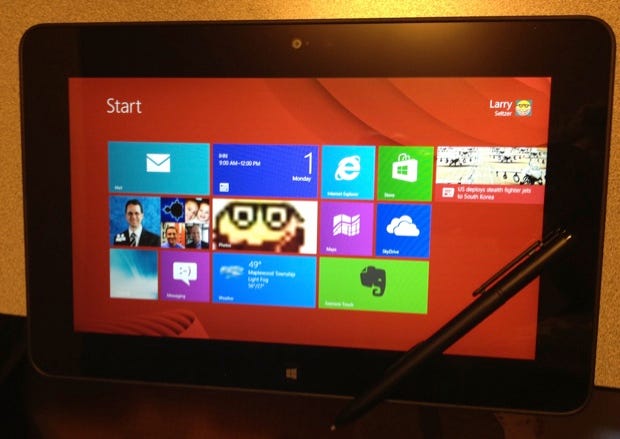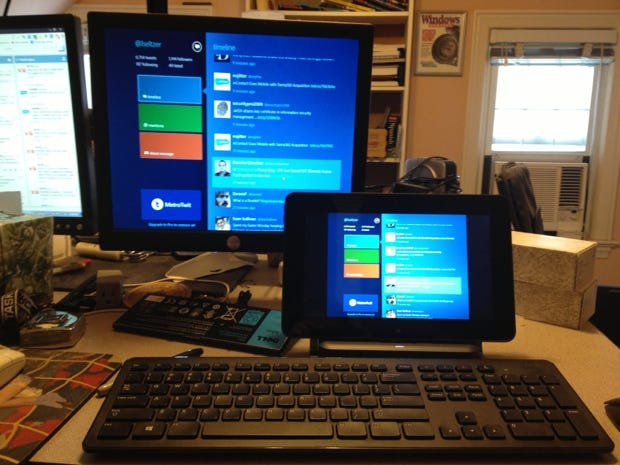Dell Latitude 10-ST2 Windows 8 Pro Tablet: the Good and the Bad
The Dell Latitude 10-ST2 is billed as a full Windows 8 Pro tablet and Microsoft Surface Pro competitor. Like Windows 8 itself, the product isn't completely baked yet.

Tablet computing is all the rage right now. Apple has its iPad and iPad mini. Samsung has the Android-powered Galaxy Tab and Galaxy Note; and Microsoft has Surface RT and Surface Pro. Dell also has a Windows 8 Pro tablet – The Dell Latitude 10-ST2. How does it measure up to the expected tablet experience? Is it a good alternative to either the 64GB or 128GB Microsoft Surface Pro tablet? Let's take an in-depth look and find out.
Tablet
The Dell Latitude 10-ST2 tablet is all black and covered on five sides with a slightly rubberized backing. The front is Gorilla Glass. It has a 10.2-inch diagonal screen pushing a 1366 x 768 resolution that defaults to landscape orientation. Its basic hardware specs can be found in the table below. After all is said and done, the device had a Windows Experience Index value of 3.3, attributed to its gaming and 3D business graphics.

The Dell Latitude 10-ST2 with its pen
The Dell Latitude 10-ST2 with its pen. Click for larger image.
The Atom processor doesn't have a lot of horse power. In fact, it's pretty anemic. The system is optimized for a few specific apps – Microsoft Office being one of them – but don't expect it to power through anything else. The weak processor performance even seems to affect network traffic, disk I/O and display performance as well, though obviously system interaction between dedicated subcomponents will also factor in.
At 1.6 pounds, the device is also just a bit heavier than the iPad 4, which weighs 1.44 pounds. Believe me, you feel it. After a few hours of carrying the device from meeting to meeting and handling it as a digital notepad, you really notice how heavy and solid the device is. It doesn't feel cheap at all, though the $40 Dell carrying case that I got with it does. It's really nothing more than rubberized, plastic coated paper. This last issue is a bit of a sore spot for me with tablets in general. They're expensive, and finding a decent case made to specifically fit the tablet you've purchased, that doesn't cost an arm and a leg, is definitely not easy.
Screen
The screen is really nice to look at, though the device wastes a lot of real estate with its 1-plus inch bezel. I understand that digitizers can be expensive, but this is silly.
Touch sensitivity is good, but pen input leaves a bit to be desired. There really isn't any pressure sensitivity settings in the digitizer, so pressing harder on the Wacom active stylus doesn't do squat, no matter how often I do it. Its accuracy, even after calibrating and recalibrating is still noticeably off
There's also some screen lag the device isn't as responsive when writing with digital ink as it should be. At times, the gap between what's being drawn on the screen and the position of the pen is a little too large. The screen should be able to display what the pen writes before the pen really moves on.
Docking Station
The Dell Latitude 10 ST2 is one of the few Windows 8 Pro tablets I know of that comes with a desktop styled docking station, which provides a base to charge the tablet as well as monitor and LAN connectivity. It also provides a number of USB 2.0 ports and an audio port. It's not a bad option, but it's not providing a compelling reason to purchase the tablet.
The biggest problem I've seen with the docking station is that it doesn't have a standard PC monitor port. While mini HDMI isn't a bad port choice, most existing monitors don't have a mini HDMI port on them. In fact, there aren't a lot of PC monitors that have HDMI ports on them, either. But HDMI to VGA connectors are cheap.

The Dell Latitude 10-ST2 in its docking station with monitor, wireless keyboard and mouse
The Dell Latitude 10-ST2 in its docking station with monitor, wireless keyboard and mouse. Click for larger image.
Camera
The Dell Latitude 10 ST2 has an integrated 720p HD front-facing video webcam and 8.0M pixel rear-facing camera. Taking stills with the tablet's rear-facing camera isn't easy, but then again, taking photos with a 10-inch piece of glass and electronics wouldn't be easy in the best of conditions. What compounds the situation is that there's no hardware button wired to snap the shutter when the Camera app is active. The device is heavy enough that you really want two hands to hold it with, to keep it steady and there's no way to attach a tripod or monopod to it. You'll need a third appendage to tap the screen in order to snap the shot.
Front-facing video was not as difficult. Here, I could hold the device in my lap and video chat via Skype. Once the device was sitting the way I wanted it, and was stable, things were rather easy. The 720p camera was nice for video chatting. It eats up the bandwidth, but the person you're chatting with should get some nice images.
Soft and Hard Keyboard
Can someone please explain why the Dell consumer-based, Windows RT tablet has a "mobile keyboard dock" and the professional, business oriented, Windows 8 Pro tablet doesn't? In case you're curious, the XPS 10 keyboard dock does not work with the Latitude 10.
Instead of a keyboard dock, the Dell Latitude 10 ST2 has a "professional" docking station, which I would gladly give away or leave on the side of the road for clickable or portable keyboard dock. The docking station is stationary and tied to my desk. I can't carry it with me, and wouldn't want to. I'm forced to use either a wired USB or wireless Bluetooth keyboard with the tablet. Poor engineering and design choices are running rampant here, especially in light of Microsoft's very public and quite successful Surface commercials showing their portable, changeable, clickable keyboards.
Mobile Broadband Connectivity and Wireless Setup
First off, what should have been a very simple process of entering my email address, wireless number and necessary account information instead required a 45-minute call to AT&T so that the device could be activated with the 4G (HSPA+) SIM that came with it. Activating the device on my shared mobile data plan should have been totally user self-serviceable. Instead, I ended up having to factory reset the device and start from scratch, as AT&T AllAccess got "confused" due to the number of failed attempts to get the device activated.
The Latitude 10 ST2 is available with an AT&T mobile broadband card, and I have a 10GB shared data plan. Coverage in and around the Chicago area is pretty good, and my ST2 came with one installed. I had a couple of issues getting the card activated (see the section on Dell Backup and Recovery, below) but while the radio was working, it performed well. I say while it was working because after about a week and a half or so with the tablet, I’m waiting on a replacement from Dell.
The Mobile Broadband card appears to be broken. The device's HSPA+ radio doesn't show up as an available network option for available networks and the device doesn't even show up in Device Manager. I tend to baby every device I work with, and I don’t have any other issues with any other connectivity options. The device's Wi-Fi and Bluetooth radios both still work.
Dell doesn't make and inventory any device or PC. Its JIT (just in time) manufacturing system builds everything to order. So, I'm currently waiting for a replacement that may take up to four weeks to arrive. It’s a good thing the Wi-Fi radio still works; at least I can use the personal hotspot in my iPhone to keep me going until the replacement device arrives.
Dell Backup and Recovery
During my time with the device, I have had cause to perform a full system wipe or hard reset. Running Dell Backup and Recovery or any factory reset process on a touch screen system that won't support touch in recovery mode is actually not only difficult -- it’s ridiculous. In order to factory reset the device, you need to attach a USB keyboard into the one and only USB2 port on the actual tablet.
Previous versions of Windows, heck, even versions of DOS for that matter... clearly indicated which screen object had focus. This was not the case here. I went back and forth from Windows 8 Desktop to the Dell Back and Recovery console numerous times, trying to tap or click the word "Next," so that I could restore the system to factory fresh settings. I finally got it after my fifth try, but had to use that USB keyboard I mentioned and a combination of the tab key, arrow keys and the enter key.
Restoring a tablet or slate device that doesn't have a keyboard shouldn't require the use of any keyboard, let alone a USB keyboard.
During my time with the Dell Latitude 10 ST2, I also had cause to return the device. The mobile broadband card broke and I had Dell send out a replacement. As a result, I had to remove the data off of the old tablet and prep it for return.
Windows 8's control panel provides a way to reset the PC, taking it back to factory fresh, making it easy to rebuild. The only problem is that simply erasing my personal information wasn't enough. I wanted to wipe everything, including the software I installed.
That complete reset took well over three hours to complete. I think Dell flew the software in, one bit at a time...It’s nice that Microsoft built this into Windows 8, but not so cool that it took over three hours to complete. That was really painful to wait on.
Battery Life & Performance
The device is S L O W.
The device functions acceptably with some software, including Microsoft Office 2010 and Office 2013. But my experience is that in most cases, the device is slow, even with its own built-in software, like Dell Backup and Recovery, as I noted previously. The device gained an unimpressive Windows Experience Index of 3.3, and it lacks any real performance highlights. This is no doubt directly related to the 1.8GHz Intel Atom z2760 processor. It might have a "fast" GHz speed rating, but it doesn't have the same processing power as Intel's i5 found in other Windows 8 tablets, like Microsoft's Surface Pro.
However, its battery life was really very good. The device was on for nearly six hours before it dropped below a 70 percent battery charge. After a 10-hour work day for me, the device never fell below 45 percent with light-to-casual use and an active HSPA+ connection.
Conclusion
If you're intending the Dell Latitude 10 ST2 to be a primary PC, don't waste your time. The device lacks any serious computing power to be able to do anything staid over the long haul. It's going to be OK for some light word processing, spreadsheets, etc. – anything from the MS Office Suite, as long as the file isn't macro or graphic intensive or too large – but you're going to want to kill yourself if you try to pull up a graphics editor and draw or edit pictures, or a multimedia editor and try to edit audio or video. I found the experience to be really that painful, and most users won't be able to move past it.
For light email, Web browsing, and textual content consumption, the device is more than acceptable. For a business trip or around the office as a digital notepad, it's awesome; but I don't think anyone, myself included, would want this or any Windows 8 Pro tablet, to be their primary work PC.
About the Author(s)
You May Also Like





